Sunday, June 04, 2006
Day 4: Three Saints Bay, Kodiak Island, Alaska
NOAA Teacher At Sea: Jacob Tanenbaum
NOAA Ship MILLER FREEMAN
Mission: Bering Sea Fisheries Research
Day 4: June 4, 2006
Weather Data from the Bridge:
Visibility: 12 miles
Wind Speed: 3.4 miles per hour
Sea Wave Height: 0
Water Temperature: 48.56 degrees
Air Temperature: 73.04
Pressure: 1014.2 Millibars
Personal Log:
I have traveled a fair bit, and have never seen a more beautiful place then Three Sai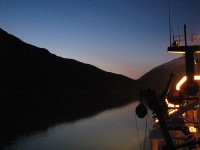 nts Bay. It is a long curved inlet in a remote part of Kodiak Island. There are snow capped mountains on all sides which are filled with mountain goats. Several streams can be seen coming into the bay and one has a water fall several hundred feet high. Yes, in answer to many of your questions, there is a lot of snow. Even though the air is warm during the day. I also see that many of you are interested in what the night is like. Here is a photo. Last night, I stayed on deck for most of the night. There were a few hours of darkness, but part of the sky was still light. This photo shows the darkest the sky became. It only lasted a short time before the sky became lighter again.
nts Bay. It is a long curved inlet in a remote part of Kodiak Island. There are snow capped mountains on all sides which are filled with mountain goats. Several streams can be seen coming into the bay and one has a water fall several hundred feet high. Yes, in answer to many of your questions, there is a lot of snow. Even though the air is warm during the day. I also see that many of you are interested in what the night is like. Here is a photo. Last night, I stayed on deck for most of the night. There were a few hours of darkness, but part of the sky was still light. This photo shows the darkest the sky became. It only lasted a short time before the sky became lighter again.
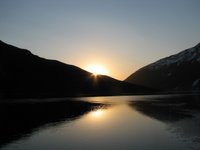
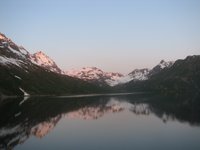
Three Saints Bay is also home to many animals. Because it is so remote, wildlife thrives here. We saw many mountain goats, and we even spotted a bear. I could not get to my camera in time for the bear, but I did take pictures of some mountain goats. Can you find them in this photo? Try clicking the picture with your mouse to enlarge it. Good luck! They are hard to find.
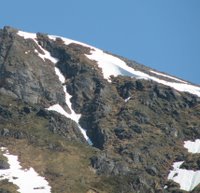
Science Log:
It has been an active 24 hours since we left port. Last night we arrived in Three Saints Bay. A quiet area in a remote part of Kodiak Island. We needed the calm waters to set up our equipment for the survey in the Bering Sea. Our first step is to Calibrate our sonar. A sonar bounces sound waves off of objects in the water, like fish. When the signal comes back, computers display what is in the water below the ship on a screen. A good sonar, like the one we have, can tell where the fish are below the ship. Some bats use a kind of natural son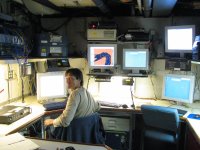 ar to “see” insects at night. But first, we have to calibrate the sonar. When you calibrate something, you make sure that it measures exactly right. To do this, we put metal balls below the ship, right under the sonar. Since we already knew the size of the balls, we could make sure the size that the sonar told us was correct. If it was not, we could adjust the sonar. The trick was, getting the metal balls right under the center of the ship. To do this, some scientists and I got on deck around 1 AM this morning (ships like this work 24 hours a day). We stretched a weighted rope across the stern (back) of the ship and then dragged each end up the deck. We had to use long hooks on poles to get it around obstacles all the way to the middle of the ship. After that, we hooked the rope up to 3 small cranes which were controlled by a computer operator in the lab down below. He could move the balls backwards, forwards, left and right using the cranes (aft, forward, port and starboard). Once they were right below the center of the ship, we could make sure the sonar was giving us correct measurements.
ar to “see” insects at night. But first, we have to calibrate the sonar. When you calibrate something, you make sure that it measures exactly right. To do this, we put metal balls below the ship, right under the sonar. Since we already knew the size of the balls, we could make sure the size that the sonar told us was correct. If it was not, we could adjust the sonar. The trick was, getting the metal balls right under the center of the ship. To do this, some scientists and I got on deck around 1 AM this morning (ships like this work 24 hours a day). We stretched a weighted rope across the stern (back) of the ship and then dragged each end up the deck. We had to use long hooks on poles to get it around obstacles all the way to the middle of the ship. After that, we hooked the rope up to 3 small cranes which were controlled by a computer operator in the lab down below. He could move the balls backwards, forwards, left and right using the cranes (aft, forward, port and starboard). Once they were right below the center of the ship, we could make sure the sonar was giving us correct measurements.
The sonar is mounted on the bottom of the ship, and should be checked before each survey to make sure it is working correctly. Since it is mounted to the bottom of the ship, we can not bring it up to look it over. This means divers had to go down into the water in order to check it.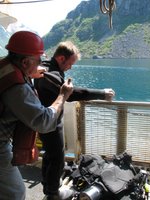 Divers suited up and went below this afternoon. The water was 48 degrees. It would be very unsafe to swim in such water, so the divers suited up in what is called a dry suit. A dry suit is allows you to enter the water without getting your skin wet. The divers also needed to have masks, so they could see, tanks of air so they could breathe, weights, tools and fins to help them swim. They jumped off the side of the ship and went below the center to check and make sure all the bolts on the sonar were secure. After 10 minutes, they emerged on the other side of the ship. They took off their tanks, weights, and other tools and put them in a small launch (little boat) that was in the water to help them. The climbed from there back into the boat, while the gear was passed up to the ship.
Divers suited up and went below this afternoon. The water was 48 degrees. It would be very unsafe to swim in such water, so the divers suited up in what is called a dry suit. A dry suit is allows you to enter the water without getting your skin wet. The divers also needed to have masks, so they could see, tanks of air so they could breathe, weights, tools and fins to help them swim. They jumped off the side of the ship and went below the center to check and make sure all the bolts on the sonar were secure. After 10 minutes, they emerged on the other side of the ship. They took off their tanks, weights, and other tools and put them in a small launch (little boat) that was in the water to help them. The climbed from there back into the boat, while the gear was passed up to the ship.
It was impressive to watch the true team effort. The divers were assisted at all times by the captain and crew. They were helped into their suit and with their tools. All other work on the ship stops while dive operations are in progress. The operations involved two divers and 5 or 6 crew members who were assisting. CLICK HERE FOR VIDEO and you will see what I mean!!
Lets meet one of the divers
Name: Kris Mackie, Chief boatswain of NOAA Ship MILLER FREEMAN
JT: How did you get to be a NOAA diver?
KM: At the beginning, there were quite a few divers on board, the ship. When they left, I actually got to fill the position. I was reluctant to be a diver at first, I was scared of the idea, but I talked myself into it and went after it. I had never done it before in my life.
JT: What was the training like?
KM: Training was intense. It was three weeks of half-day of textbooks and research and the other half of the day was spent doing multi-dives; 3 or four dives per day. As small as practicing with fins in a pool and progressing up to breathing under the water. It was kind of a kick. Something you have to get past at first. There is a lot of pressure on your chest. Once you get past that it is OK.
JT: How do you like it now?
KM: It is pretty cool. Most of the dives I experience are cold water working dives, I have yet to have the experience of warm water recreational diving. I
have seen a lot of interesting things.
JT: Like what:
KM: What never gets old to me is watching king crab in action on the bottom. It’s pretty entertaining. If you are lucky enough to come across seals, they can get pretty interactive. They come within three or four feet
JT: What was it like below the ship today?
KM: The visibility was phenomenal. Probably 30 feet or so. Very unusual. The sun had a lot to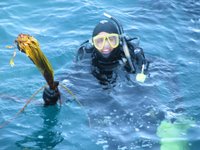 do with that today. I saw a lot of jelly fish, some needle fish. Some other small feeder fish I couldn’t identify. We found kelp wrapped in the screw (ship’s propeller). That was about it. A short dive. If we had gone to the beach we would have been under for 30 minutes or more (the photo shows Kris holding the kelp).
do with that today. I saw a lot of jelly fish, some needle fish. Some other small feeder fish I couldn’t identify. We found kelp wrapped in the screw (ship’s propeller). That was about it. A short dive. If we had gone to the beach we would have been under for 30 minutes or more (the photo shows Kris holding the kelp).
JT: I heard that you dove under the ice pack in the Bering Sea a few weeks ago. What was that like?
Click here to hear Kris describe his dive
JT: What did you do on your dive today?
KM: We were just examining the transducers that the scientists are going to use. Making sure all the screws were there and there were no scratches. We checked the center board and an did an overhaul of the vessel from stem to stern. One thing to do is to make sure the screw is free and clear because it causes noise and backscatter which interferes with the sonar.
JT: What does it take to be a NOAA Diver:
KM: One year of sea time on board ship and you have to be able to swim.
Question of the day:
How would living high in the mountains help these goats to survive?
Photos:
Night on the deck of NOAA Ship MILLER FREEMAN
Three Saints Bay at Sunrise (2 photos)
Mountain Goats in Three Saints Bay, Kodiak Island, Alaska
Michael Guttormsen works in Acoustics Lab on board NOAA Ship MILLER FREEMAN
NOAA Diver Kris Mackie is assisted into his equipment by Scott Harrington on board NOAA Ship MILLER FREEMAN
NOAA Diver Kris Mackie holds kelp he found in the propeller of NOAA Ship MILLER FREEMAN
NOAA Ship MILLER FREEMAN
Mission: Bering Sea Fisheries Research
Day 4: June 4, 2006
Weather Data from the Bridge:
Visibility: 12 miles
Wind Speed: 3.4 miles per hour
Sea Wave Height: 0
Water Temperature: 48.56 degrees
Air Temperature: 73.04
Pressure: 1014.2 Millibars
Personal Log:
I have traveled a fair bit, and have never seen a more beautiful place then Three Sai
 nts Bay. It is a long curved inlet in a remote part of Kodiak Island. There are snow capped mountains on all sides which are filled with mountain goats. Several streams can be seen coming into the bay and one has a water fall several hundred feet high. Yes, in answer to many of your questions, there is a lot of snow. Even though the air is warm during the day. I also see that many of you are interested in what the night is like. Here is a photo. Last night, I stayed on deck for most of the night. There were a few hours of darkness, but part of the sky was still light. This photo shows the darkest the sky became. It only lasted a short time before the sky became lighter again.
nts Bay. It is a long curved inlet in a remote part of Kodiak Island. There are snow capped mountains on all sides which are filled with mountain goats. Several streams can be seen coming into the bay and one has a water fall several hundred feet high. Yes, in answer to many of your questions, there is a lot of snow. Even though the air is warm during the day. I also see that many of you are interested in what the night is like. Here is a photo. Last night, I stayed on deck for most of the night. There were a few hours of darkness, but part of the sky was still light. This photo shows the darkest the sky became. It only lasted a short time before the sky became lighter again.

Three Saints Bay is also home to many animals. Because it is so remote, wildlife thrives here. We saw many mountain goats, and we even spotted a bear. I could not get to my camera in time for the bear, but I did take pictures of some mountain goats. Can you find them in this photo? Try clicking the picture with your mouse to enlarge it. Good luck! They are hard to find.

Science Log:
It has been an active 24 hours since we left port. Last night we arrived in Three Saints Bay. A quiet area in a remote part of Kodiak Island. We needed the calm waters to set up our equipment for the survey in the Bering Sea. Our first step is to Calibrate our sonar. A sonar bounces sound waves off of objects in the water, like fish. When the signal comes back, computers display what is in the water below the ship on a screen. A good sonar, like the one we have, can tell where the fish are below the ship. Some bats use a kind of natural son
 ar to “see” insects at night. But first, we have to calibrate the sonar. When you calibrate something, you make sure that it measures exactly right. To do this, we put metal balls below the ship, right under the sonar. Since we already knew the size of the balls, we could make sure the size that the sonar told us was correct. If it was not, we could adjust the sonar. The trick was, getting the metal balls right under the center of the ship. To do this, some scientists and I got on deck around 1 AM this morning (ships like this work 24 hours a day). We stretched a weighted rope across the stern (back) of the ship and then dragged each end up the deck. We had to use long hooks on poles to get it around obstacles all the way to the middle of the ship. After that, we hooked the rope up to 3 small cranes which were controlled by a computer operator in the lab down below. He could move the balls backwards, forwards, left and right using the cranes (aft, forward, port and starboard). Once they were right below the center of the ship, we could make sure the sonar was giving us correct measurements.
ar to “see” insects at night. But first, we have to calibrate the sonar. When you calibrate something, you make sure that it measures exactly right. To do this, we put metal balls below the ship, right under the sonar. Since we already knew the size of the balls, we could make sure the size that the sonar told us was correct. If it was not, we could adjust the sonar. The trick was, getting the metal balls right under the center of the ship. To do this, some scientists and I got on deck around 1 AM this morning (ships like this work 24 hours a day). We stretched a weighted rope across the stern (back) of the ship and then dragged each end up the deck. We had to use long hooks on poles to get it around obstacles all the way to the middle of the ship. After that, we hooked the rope up to 3 small cranes which were controlled by a computer operator in the lab down below. He could move the balls backwards, forwards, left and right using the cranes (aft, forward, port and starboard). Once they were right below the center of the ship, we could make sure the sonar was giving us correct measurements.The sonar is mounted on the bottom of the ship, and should be checked before each survey to make sure it is working correctly. Since it is mounted to the bottom of the ship, we can not bring it up to look it over. This means divers had to go down into the water in order to check it.
 Divers suited up and went below this afternoon. The water was 48 degrees. It would be very unsafe to swim in such water, so the divers suited up in what is called a dry suit. A dry suit is allows you to enter the water without getting your skin wet. The divers also needed to have masks, so they could see, tanks of air so they could breathe, weights, tools and fins to help them swim. They jumped off the side of the ship and went below the center to check and make sure all the bolts on the sonar were secure. After 10 minutes, they emerged on the other side of the ship. They took off their tanks, weights, and other tools and put them in a small launch (little boat) that was in the water to help them. The climbed from there back into the boat, while the gear was passed up to the ship.
Divers suited up and went below this afternoon. The water was 48 degrees. It would be very unsafe to swim in such water, so the divers suited up in what is called a dry suit. A dry suit is allows you to enter the water without getting your skin wet. The divers also needed to have masks, so they could see, tanks of air so they could breathe, weights, tools and fins to help them swim. They jumped off the side of the ship and went below the center to check and make sure all the bolts on the sonar were secure. After 10 minutes, they emerged on the other side of the ship. They took off their tanks, weights, and other tools and put them in a small launch (little boat) that was in the water to help them. The climbed from there back into the boat, while the gear was passed up to the ship.It was impressive to watch the true team effort. The divers were assisted at all times by the captain and crew. They were helped into their suit and with their tools. All other work on the ship stops while dive operations are in progress. The operations involved two divers and 5 or 6 crew members who were assisting. CLICK HERE FOR VIDEO and you will see what I mean!!
Lets meet one of the divers
Name: Kris Mackie, Chief boatswain of NOAA Ship MILLER FREEMAN
JT: How did you get to be a NOAA diver?
KM: At the beginning, there were quite a few divers on board, the ship. When they left, I actually got to fill the position. I was reluctant to be a diver at first, I was scared of the idea, but I talked myself into it and went after it. I had never done it before in my life.
JT: What was the training like?
KM: Training was intense. It was three weeks of half-day of textbooks and research and the other half of the day was spent doing multi-dives; 3 or four dives per day. As small as practicing with fins in a pool and progressing up to breathing under the water. It was kind of a kick. Something you have to get past at first. There is a lot of pressure on your chest. Once you get past that it is OK.
JT: How do you like it now?
KM: It is pretty cool. Most of the dives I experience are cold water working dives, I have yet to have the experience of warm water recreational diving. I
have seen a lot of interesting things.
JT: Like what:
KM: What never gets old to me is watching king crab in action on the bottom. It’s pretty entertaining. If you are lucky enough to come across seals, they can get pretty interactive. They come within three or four feet
JT: What was it like below the ship today?
KM: The visibility was phenomenal. Probably 30 feet or so. Very unusual. The sun had a lot to
 do with that today. I saw a lot of jelly fish, some needle fish. Some other small feeder fish I couldn’t identify. We found kelp wrapped in the screw (ship’s propeller). That was about it. A short dive. If we had gone to the beach we would have been under for 30 minutes or more (the photo shows Kris holding the kelp).
do with that today. I saw a lot of jelly fish, some needle fish. Some other small feeder fish I couldn’t identify. We found kelp wrapped in the screw (ship’s propeller). That was about it. A short dive. If we had gone to the beach we would have been under for 30 minutes or more (the photo shows Kris holding the kelp).JT: I heard that you dove under the ice pack in the Bering Sea a few weeks ago. What was that like?
Click here to hear Kris describe his dive
JT: What did you do on your dive today?
KM: We were just examining the transducers that the scientists are going to use. Making sure all the screws were there and there were no scratches. We checked the center board and an did an overhaul of the vessel from stem to stern. One thing to do is to make sure the screw is free and clear because it causes noise and backscatter which interferes with the sonar.
JT: What does it take to be a NOAA Diver:
KM: One year of sea time on board ship and you have to be able to swim.
Question of the day:
How would living high in the mountains help these goats to survive?
Photos:
Night on the deck of NOAA Ship MILLER FREEMAN
Three Saints Bay at Sunrise (2 photos)
Mountain Goats in Three Saints Bay, Kodiak Island, Alaska
Michael Guttormsen works in Acoustics Lab on board NOAA Ship MILLER FREEMAN
NOAA Diver Kris Mackie is assisted into his equipment by Scott Harrington on board NOAA Ship MILLER FREEMAN
NOAA Diver Kris Mackie holds kelp he found in the propeller of NOAA Ship MILLER FREEMAN
Comments:
<< Home
Dear Mr. T,
We are the students in Mrs. Fanning's class at TZE. This is the first time we have learned about you being a teacher at sea. We have a few questions for you .....
Are there any sharks in Alaska? Sea turtles? How many people are on board the ship? Are you having fun? What has the weather been like? How do you feel? Are you sea sick yet? Be well. Ms. Eyer & Ms. Fanning's class
We are the students in Mrs. Fanning's class at TZE. This is the first time we have learned about you being a teacher at sea. We have a few questions for you .....
Are there any sharks in Alaska? Sea turtles? How many people are on board the ship? Are you having fun? What has the weather been like? How do you feel? Are you sea sick yet? Be well. Ms. Eyer & Ms. Fanning's class
The pictures of the water are so awesome we can't stand it! Did the divers say how cold the water is? How far down did they dive? How long can they stay in the water? How come there weren't any yellow labs in that boat? We could show those guys a thing about swimming!
Love from your Angels in Canine Bodies!
Jassie and Misha
Love from your Angels in Canine Bodies!
Jassie and Misha
How heavy were the metal balls underwater?
Was Snuggy a real bear?
How many animals did you see?
What does NOAA stand for?
Why were you picked for the trip?
What exactly do you do on the ship?
What is the ship like?
What are the bathroom showers like?
Is the food the same?
Can you only eat fish?
Mrs. Berman's Class
Was Snuggy a real bear?
How many animals did you see?
What does NOAA stand for?
Why were you picked for the trip?
What exactly do you do on the ship?
What is the ship like?
What are the bathroom showers like?
Is the food the same?
Can you only eat fish?
Mrs. Berman's Class
Dear Mr. T,
Hi, this is Mrs. Schaefer's third grade class from TZE.
Questions & Comments:
I think you have a lot of courage to go to sea. I wish I could be out to sea in Alaska.I hope you are having a lot of fun studying the Pollack fish. How is the food?I hope Snuggy is safe!
P.S. Do you like pie? Did you know that blueberry pie is the state food?
Hi, this is Mrs. Schaefer's third grade class from TZE.
Questions & Comments:
I think you have a lot of courage to go to sea. I wish I could be out to sea in Alaska.I hope you are having a lot of fun studying the Pollack fish. How is the food?I hope Snuggy is safe!
P.S. Do you like pie? Did you know that blueberry pie is the state food?
Dear Mr. T,
Mrs. Rudolph's class just watched some of your video and sound clips and learned about your trip and has a few questions and comments for you. Have you seen any swordfish or sharks? Penguins? How did you feel when you first heard you were going on this trip?We hope you are having fun? Peace OUT! Mrs. Rudolph's class & Ms. Eyer
Mrs. Rudolph's class just watched some of your video and sound clips and learned about your trip and has a few questions and comments for you. Have you seen any swordfish or sharks? Penguins? How did you feel when you first heard you were going on this trip?We hope you are having fun? Peace OUT! Mrs. Rudolph's class & Ms. Eyer
So far what was your favorite part of your trip?
Did you get to see the Northern Lights yet?
How far down did he dive?
Mrs. Jean's Class
Did you get to see the Northern Lights yet?
How far down did he dive?
Mrs. Jean's Class
Hi Mr. T,
We had a great time looking at your pictures today. We tried to count the mountain goats, but couldn't. The pictures from Three Saints Bay are beautiful! We were very confused as to why you were wearing short sleeves. We didn't realize that it could be hot in Alaska too! Wow! We can't wait to find out if you get seasick! Have you seen any whales or sharks? Could you take pictures of them if you do?
Talk to you soon!
Mrs. Costello's Class
We had a great time looking at your pictures today. We tried to count the mountain goats, but couldn't. The pictures from Three Saints Bay are beautiful! We were very confused as to why you were wearing short sleeves. We didn't realize that it could be hot in Alaska too! Wow! We can't wait to find out if you get seasick! Have you seen any whales or sharks? Could you take pictures of them if you do?
Talk to you soon!
Mrs. Costello's Class
Hi Jacob:
Ahoy Matey.....It's Barbara here. Shiver my timbers!!!
I looked through all of your pictures and have been reading your blog entries. The scenery is beautiful and it seems like you are really enjoying yourself.
Are you having a good time socializing with the sailors, scientists and others? Are there any women aboard? Do you have any television reception? What is your bed like?
Hope all is well...Keep away from the plank!
-Barbara
Ahoy Matey.....It's Barbara here. Shiver my timbers!!!
I looked through all of your pictures and have been reading your blog entries. The scenery is beautiful and it seems like you are really enjoying yourself.
Are you having a good time socializing with the sailors, scientists and others? Are there any women aboard? Do you have any television reception? What is your bed like?
Hope all is well...Keep away from the plank!
-Barbara
Dear Mr. T,
This is Mrs. Fleming's class at TZE.We have some questions and comments: We wonder what you are eating? What is it like on the ship? Is it bumpy? Did you ever get seasick? Did you bring any books,if not, "Why NOT?" If yes,"What Kind?"
Your friends, Mrs. Fleming's class & Ms. Eyer
This is Mrs. Fleming's class at TZE.We have some questions and comments: We wonder what you are eating? What is it like on the ship? Is it bumpy? Did you ever get seasick? Did you bring any books,if not, "Why NOT?" If yes,"What Kind?"
Your friends, Mrs. Fleming's class & Ms. Eyer
Super blog entry today, Mr. Tanenbaum. The photos, sound clip and video clip were awesome! Kudos to Mr. Mackie for overcoming his fears and learning how to dive to help the team continue their research. He is an inspiration to us all.
Ms. Christie-Blick
Ms. Christie-Blick
OOOOOOOOH JACOB IT'S ZACK. I HOPE YOU ARE HAVING FUN. SAY HI TO ME IN YOUR NEXT BLOG PLLLLLEEEAAASSE. Did the kelp in the propeller interfere with the speed of the ship? REMEMBER TO SAY HI!!!!!!!!!!!!!!!!!!!!!! OK SEE YA.
FROM ZACK YOUR BROTHER'S SON
FROM ZACK YOUR BROTHER'S SON
June 6, 2006
Will you get to be a diver some day?
How long does it take to get the equipment on?
Is your bed comfy?
Mrs. Wagner's Class
Will you get to be a diver some day?
How long does it take to get the equipment on?
Is your bed comfy?
Mrs. Wagner's Class
June 6, 2006
How long is the Three Saints Bay?
How quickly did the guy in the video get out of the water?
What colored birds did you see?
Mrs. Rudin's Class
How long is the Three Saints Bay?
How quickly did the guy in the video get out of the water?
What colored birds did you see?
Mrs. Rudin's Class
June 6, 2006
When you saw the goats and bears were you on land or water and how did you spot them?
How many bears did you spot?
Mr. Onativia's Class
Post a Comment
When you saw the goats and bears were you on land or water and how did you spot them?
How many bears did you spot?
Mr. Onativia's Class
<< Home







